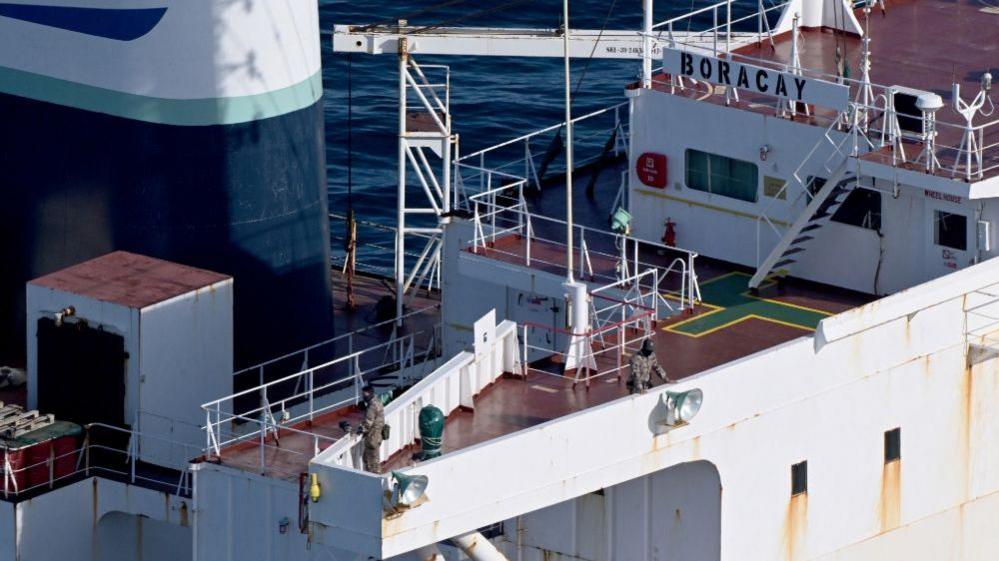French troops board oil tanker linked to Russian 'shadow fleet'

French forces aboard the Boracay on Wednesday
- Published
French soldiers have boarded an oil tanker believed to be part of Russia's "shadow fleet", used to evade sanctions imposed because of the war in Ukraine.
The Boracay left Russia last month and was off the coast of Denmark when unidentified drones forced the temporary closure of several airports last week. It has been anchored off western France for a few days.
French President Emmanuel Macron said at an EU leaders' summit in Copenhagen on Wednesday that the crew had committed "serious offences", but did not elaborate.
Kremlin spokesman Dmitry Peskov said Russia had no knowledge of the vessel.
News agency AFP quoted a source as saying French military personnel had boarded the vessel on Saturday.
Macron refused to be drawn on the question of whether the ship may have been used as a platform for the drone flights that caused such disruption in Denmark last week.
Prosecutors in Brest have opened an investigation on two counts: refusing an order to stop and failing to justify the nationality of the ship's flag.
Many Western countries have imposed sanctions on Russian energy by limiting imports and capping the price of its oil following the start of Russia's full-scale invasion of Ukraine in 2022.
To evade these sanctions, Moscow built up what has been referred to as a "shadow fleet" of tankers whose ownership and movements could be obscured.
Russia is believed to have a fleet of several hundred tankers which are registered in other countries and are used to export its petrol. Macron said Russia's shadow fleet contained between 600 and 1,000 ships.
The Boracay, also known as Pushpa and Kiwala, is a Benin-flagged vessel but has been listed under UK and EU sanctions against Russia.
It was detained by Estonian authorities earlier this year for sailing without a valid country flag.
It had set off from the Russian port of Primorsk outside Saint Petersburg on 20 September and sailed through the Baltic Sea and past Denmark, before entering the North Sea and carrying on through the English Channel.
It had been scheduled to arrive in Vadinar in north-western India on 20 October, according to data from the Marine Traffic tracking website. However it was followed by a French warship after it rounded the Brittany coast and then altered course and headed east towards the French coast.
EU leaders have been meeting in Copenhagen under pressure to boost European defence after a series of Russian incursions into EU airspace, and days after the drones targeted Danish airports.
Copenhagen airport, followed by several Danish airports and military sites on the Jutland peninsula, faced drone disruption last week.
Danish Prime Minister Mette Frederiksen told reporters that "from a European perspective there is only one country... willing to threaten us and that is Russia, and therefore we need a very strong answer back".
Danish authorities have not found any evidence that Russia was behind last week's drone disruption, but Frederiksen linked it explicitly to other so-called hybrid attacks such as Russian drones over Poland.
It was part of a pattern that had to be viewed from a European perspective, she told reporters on Wednesday.
The incursions have become most acute for countries on the EU's eastern flank, such as Poland and Estonia.
A number of member states have already backed plans for a multi-layered "drone wall" to quickly detect, then track and destroy Russian drones.